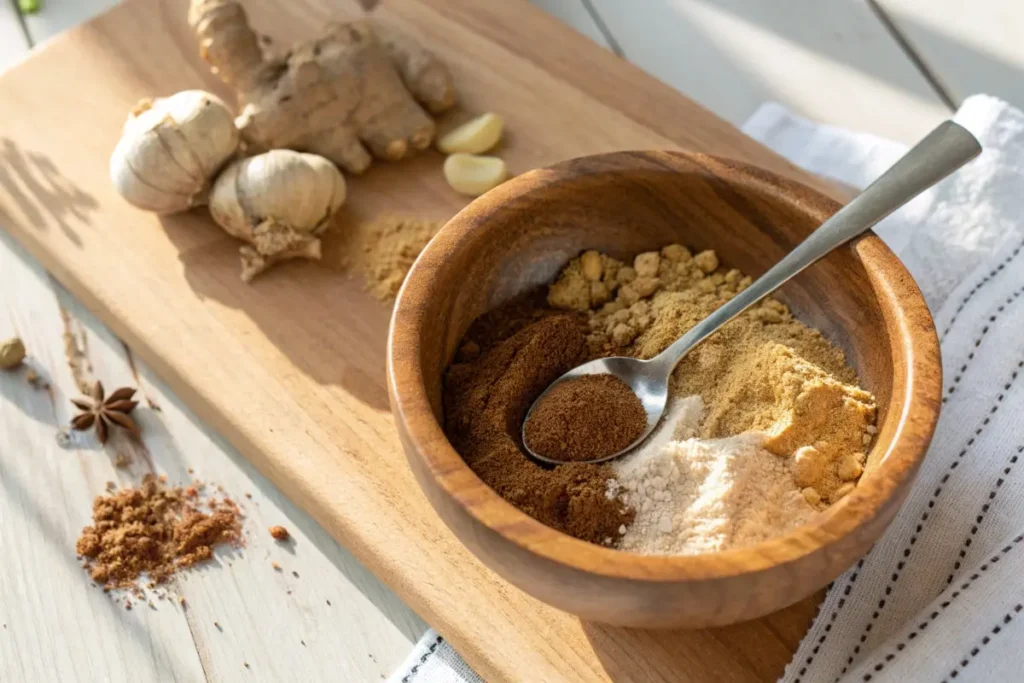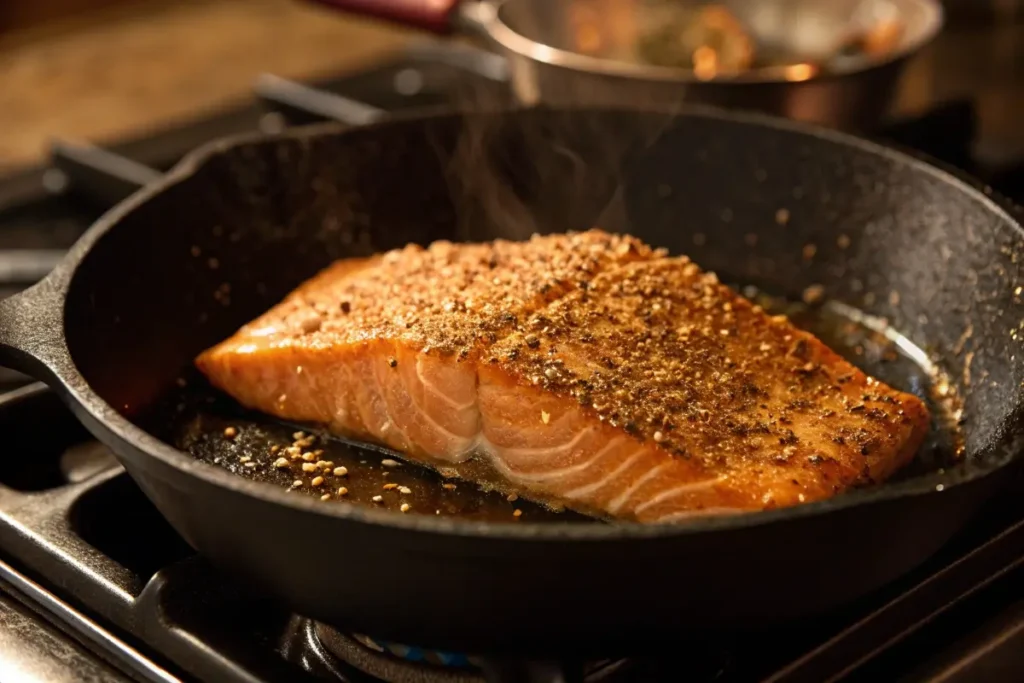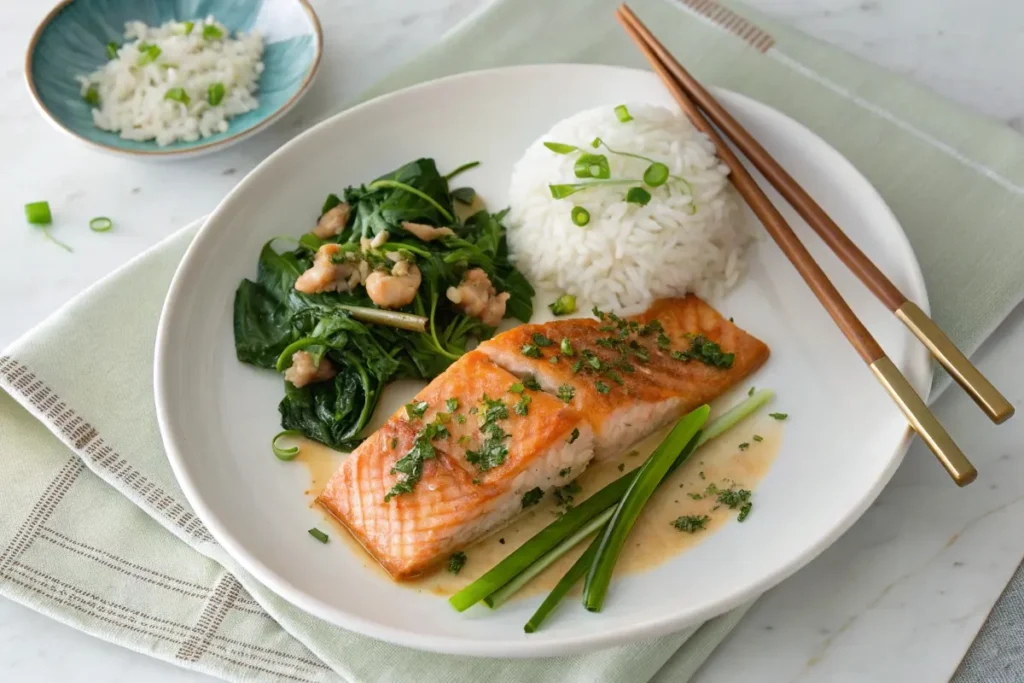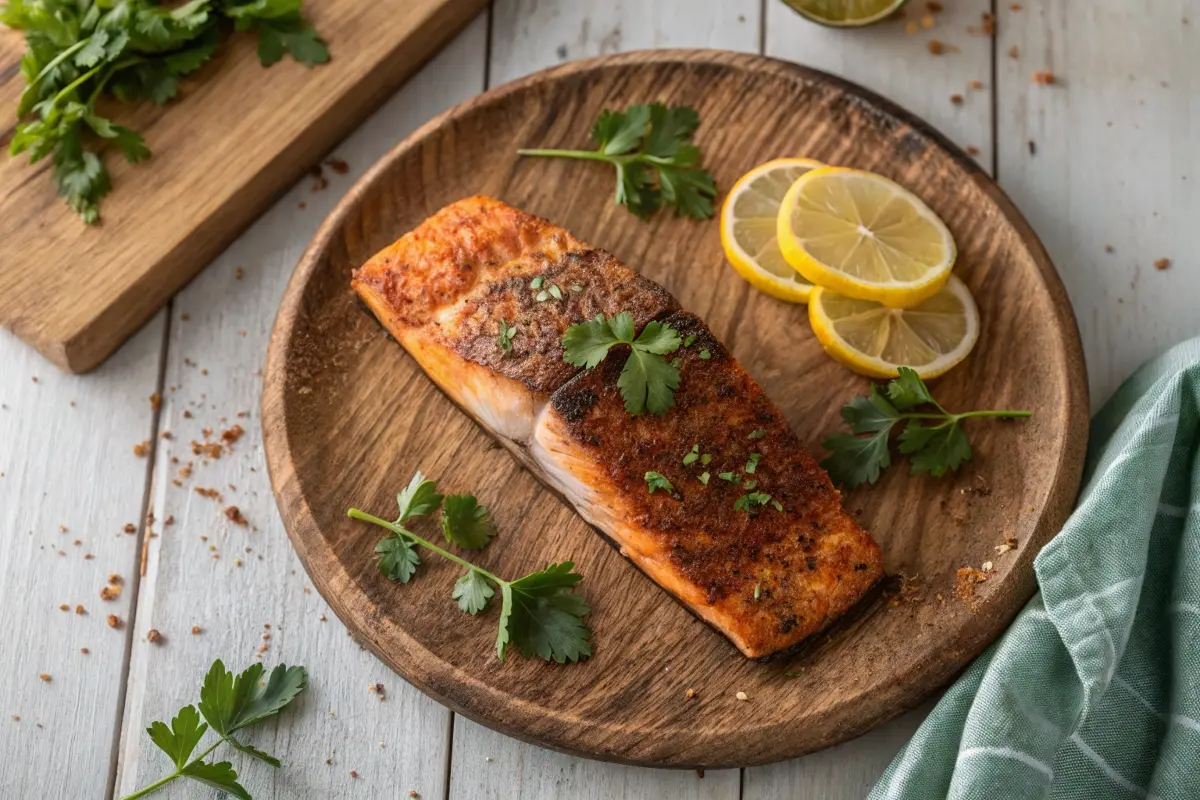If you love salmon and bold Asian flavors, then you’re in for a treat! A salmon Asian rub recipe combines aromatic spices, sweet and savory notes, and just the right amount of heat to elevate your dish. Whether you’re pan-searing, grilling, or baking, this spice blend creates a crispy, flavorful crust while keeping the salmon tender and juicy inside.
In this article, we’ll explore the best ingredients for an Asian spice rub, step-by-step preparation, and different cooking techniques to achieve restaurant-quality salmon at home. You’ll also learn about the perfect side dishes to complement the flavors and some pro tips to take your salmon to the next level.
Let’s dive in and discover how to make the ultimate salmon Asian rub recipe!
Table of Contents
Introduction to Salmon with Asian Rub
Why Asian Flavors Work So Well with Salmon
Salmon is one of the most versatile fish, known for its rich, buttery texture and mild flavor. This makes it an ideal protein to pair with bold, aromatic Asian spices. A well-crafted salmon Asian rub recipe enhances the natural flavors of the fish while adding layers of sweet, savory, spicy, and umami notes.
Unlike marinades, which require extra time to penetrate the fish, a dry spice rub forms a flavorful crust that locks in moisture and intensifies the taste. The result? A perfectly seasoned, crispy-on-the-outside, tender-on-the-inside salmon fillet that’s bursting with flavor. Whether you grill, bake, or pan-sear, an Asian spice rub takes your salmon from simple to spectacular in minutes.
Beyond its incredible taste, Asian-inspired rubs also offer health benefits. Many of the key ingredients—like ginger, garlic, and turmeric—are known for their anti-inflammatory and antioxidant properties. Paired with omega-3-rich salmon, this dish becomes not only a flavorful delight but also a nutrient-packed meal.
The Origins of Asian-Inspired Spice Rubs
Asian cuisines have a long history of using dry spice blends to enhance flavors. From the bold five-spice blends of China to the fragrant lemongrass-infused seasonings of Thailand, each culture has developed its own unique combination of seasonings.
For example, Chinese Five-Spice Powder, one of the most popular ingredients in a salmon Asian rub recipe, dates back centuries. This blend of cinnamon, star anise, cloves, Sichuan peppercorns, and fennel represents the five essential flavors: sweet, sour, bitter, salty, and umami. When paired with salmon, it creates a well-balanced depth of flavor that lingers with every bite.
Other classic Asian flavors include:
- Sesame seeds – Add a toasty, nutty crunch.
- Soy sauce powder – Boosts umami without adding extra liquid.
- Ginger and garlic – Provide a sharp, aromatic kick.
- Coriander and turmeric – Bring warmth and subtle earthiness.
- Chili flakes or cayenne – Deliver just the right amount of heat.
By blending these spices in the right proportions, you can create a restaurant-quality dish at home. Whether you’re a seasoned cook or a beginner, mastering a great salmon Asian rub recipe is easier than you think.
Essential Ingredients for the Perfect Asian Spice Rub
Core Spices for an Authentic Asian Rub
The key to a great salmon Asian rub recipe is the perfect balance of savory, sweet, and spicy flavors. Each spice plays a role in enhancing the salmon’s natural richness while adding depth to every bite. Here are the must-have ingredients:
- Chinese Five-Spice – A fragrant blend of cinnamon, star anise, cloves, Sichuan pepper, and fennel. This spice mix delivers warmth and complexity.
- Garlic Powder – Adds a savory depth that pairs beautifully with salmon.
- Ground Ginger – Provides a subtle spiciness and warmth that enhances the rub.
- Coriander Powder – Brings a slightly citrusy, earthy flavor that complements Asian seasonings.
- Cayenne Pepper or Red Pepper Flakes – Adds heat and a bit of smoky depth. Adjust based on your spice tolerance.
Balancing Sweetness and Heat
To create the ultimate flavor contrast, balancing sweetness and spice is essential. Here’s how:
- Brown Sugar or Honey Powder – Helps create a caramelized crust when cooking, adding a mild sweetness that complements the bold spices.
- Soy Sauce Powder – Introduces a deep umami taste while keeping the rub dry for easier application.
- Sesame Seeds – Adds a nutty crunch and enhances texture. Lightly toasted sesame seeds bring out the best flavor.
These ingredients work together to create a rich, flavorful crust that makes salmon irresistibly delicious. Now, let’s move on to the step-by-step process of making and applying the rub.
Step-by-Step Guide to Making the Salmon Asian Rub
Mixing the Spice Blend

Creating your own salmon Asian rub recipe is simple and rewarding. Here’s how to do it:
- Measure the Spices – In a small bowl, combine:
- 1 tablespoon Chinese Five-Spice
- 1 teaspoon garlic powder
- 1 teaspoon ground ginger
- 1 teaspoon coriander powder
- ½ teaspoon cayenne pepper (adjust to taste)
- 1 tablespoon brown sugar or honey powder
- ½ teaspoon soy sauce powder
- 1 teaspoon sesame seeds
- Mix Thoroughly – Stir all the ingredients together until evenly blended.
- Store Properly – If not using immediately, keep the rub in an airtight container in a cool, dry place for up to a month.
Preparing the Salmon for Maximum Flavor
Before applying the spice rub, it’s important to prepare the salmon properly to ensure the best results:
- Pat the Salmon Dry – Use a paper towel to remove excess moisture. This helps the rub stick better and creates a crispier crust.
- Brush with Oil – Lightly coat the salmon with a neutral oil (such as avocado or sesame oil) to help the spices adhere.
- Apply the Rub Generously – Sprinkle the spice rub evenly over the fillets, pressing it in gently to coat all sides. Let the salmon rest for 10–15 minutes to absorb the flavors before cooking.
Cooking Techniques for the Best Asian-Style Salmon
Pan-Seared Salmon with a Crispy Crust

One of the best ways to cook a salmon Asian rub recipe is by pan-searing it. This method locks in moisture, creates a flavorful crust, and brings out the depth of the spice blend.
Follow these steps for a perfectly seared salmon fillet:
- Heat the pan – Use a cast-iron skillet or nonstick pan over medium-high heat. Add a tablespoon of oil (avocado or sesame oil works best).
- Sear the salmon skin-side down – Place the fillet skin-side down first. Let it cook undisturbed for 3–4 minutes, allowing the skin to crisp up.
- Flip and finish cooking – Turn the fillet and cook for another 2–3 minutes, depending on thickness. The spice rub will form a caramelized crust.
- Rest before serving – Remove from heat and let the salmon rest for 2 minutes before serving to allow the juices to settle.
For an extra layer of flavor, drizzle a bit of fresh lime juice or a light soy glaze over the top before serving.
Oven-Baked and Grilled Options
If you prefer a hands-off cooking method, baking or grilling your salmon Asian rub recipe is an excellent choice.
Oven-Baked Method:
- Preheat the oven to 400°F (200°C) and line a baking sheet with parchment paper.
- Place the seasoned salmon on the tray, skin-side down. Drizzle lightly with oil.
- Bake for 12–15 minutes or until the fish flakes easily with a fork.
Grilled Method:
- Preheat the grill to medium-high heat (375°F – 400°F) and lightly oil the grates.
- Grill skin-side down for 4–5 minutes per side.
- Let the salmon rest before serving.
Grilled salmon takes on a subtle smoky flavor, while the baked version remains juicy and tender. Both methods allow the Asian spice rub to shine!
Serving Suggestions and Side Pairings

Best Side Dishes to Complement Asian Salmon
A well-balanced salmon Asian rub recipe pairs beautifully with light and refreshing sides that enhance the dish’s bold flavors. Here are some great options:
- Steamed Jasmine Rice – A simple side that absorbs the rich flavors of the spice rub.
- Asian Slaw – A crunchy mix of shredded cabbage, carrots, and sesame dressing adds freshness.
- Cucumber Salad – Thinly sliced cucumbers tossed in rice vinegar, soy sauce, and sesame seeds create a tangy contrast.
For those who prefer heartier sides, these dishes work well:
- Garlic Noodles – Tossed in a light soy and sesame sauce, these noodles add umami richness.
- Roasted Bok Choy or Asparagus – Drizzled with sesame oil and roasted for extra depth.
- Miso Soup – A comforting, umami-packed broth balances the salmon’s seasoning.
Garnishing for Presentation and Extra Flavor
To take your dish to the next level, consider these final touches:
- Fresh Herbs – Cilantro, Thai basil, or green onions add brightness.
- Lemon or Lime Wedges – A squeeze of citrus enhances the dish’s flavors.
- Sesame Seeds – Lightly toasted sesame seeds provide an extra crunch.
With these sides and garnishes, your salmon Asian rub recipe transforms into a restaurant-quality meal!st to the richness of the salmon. Top with sesame seeds for a bit of crunch!
FAQs About Salmon Asian Rub Recipe
Can I Make the Spice Rub in Advance?
Yes! A homemade salmon Asian rub recipe is perfect for preparing ahead of time. By mixing the spices in advance, you save time and ensure that the flavors are evenly blended.
To keep your spice rub fresh and flavorful, follow these storage tips:
- Use an airtight container – A glass jar or a sealed spice tin prevents moisture from affecting the blend.
- Store in a cool, dark place – Avoid exposing your rub to direct sunlight or heat, as this can weaken the flavors over time.
- Label and date your mix – Spices lose potency over time, so it’s best to use the blend within 4–6 weeks for optimal taste.
If you’re using fresh ingredients like minced garlic or ginger in your rub, store the mixture in the refrigerator and use it within 3–5 days.
What’s the Best Type of Salmon for This Recipe?
Choosing the right salmon makes a big difference in both flavor and texture. For the best results, consider the following:
- Wild-Caught Salmon – Varieties like sockeye, king, or coho salmon have a deeper color, firmer texture, and richer taste.
- Farm-Raised Salmon – Milder in flavor, this option is usually fattier, making it extra moist when cooked.
- Frozen vs. Fresh – Fresh salmon is ideal, but high-quality frozen salmon works just as well if thawed properly.
Pro Tip: If you’re grilling or pan-searing, opt for skin-on fillets to hold the fish together and achieve a crispy finish.
Can This Recipe Be Used for Other Proteins?
Absolutely! The bold flavors of this salmon Asian rub recipe work wonderfully on a variety of proteins. Try it with:
- Chicken – Coat chicken breasts or thighs before grilling or roasting.
- Shrimp – Toss shrimp in the rub and quickly sauté for a spicy seafood dish.
- Tofu – Press and pat dry tofu, coat it with the spice blend, and bake or pan-fry until crispy.
For extra depth, you can also sprinkle the rub over roasted vegetables, rice bowls, or even popcorn for a unique twist.
By following these tips, you’ll elevate your salmon Asian rub recipe and create a meal that’s packed with flavor, texture, and balance. Whether you’re meal-prepping, cooking for a weeknight dinner, or hosting a special gathering, this recipe is guaranteed to impress.fraid to experiment with different proteins and cooking methods.

